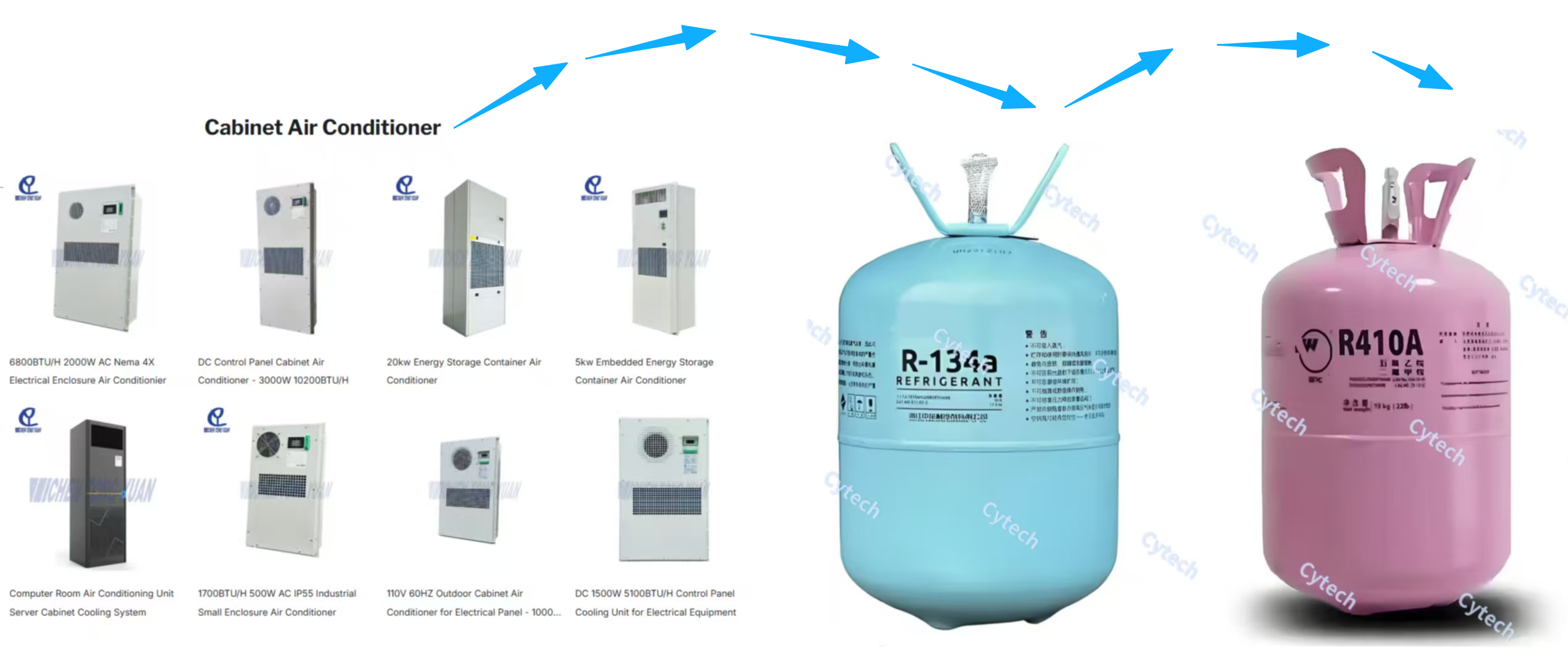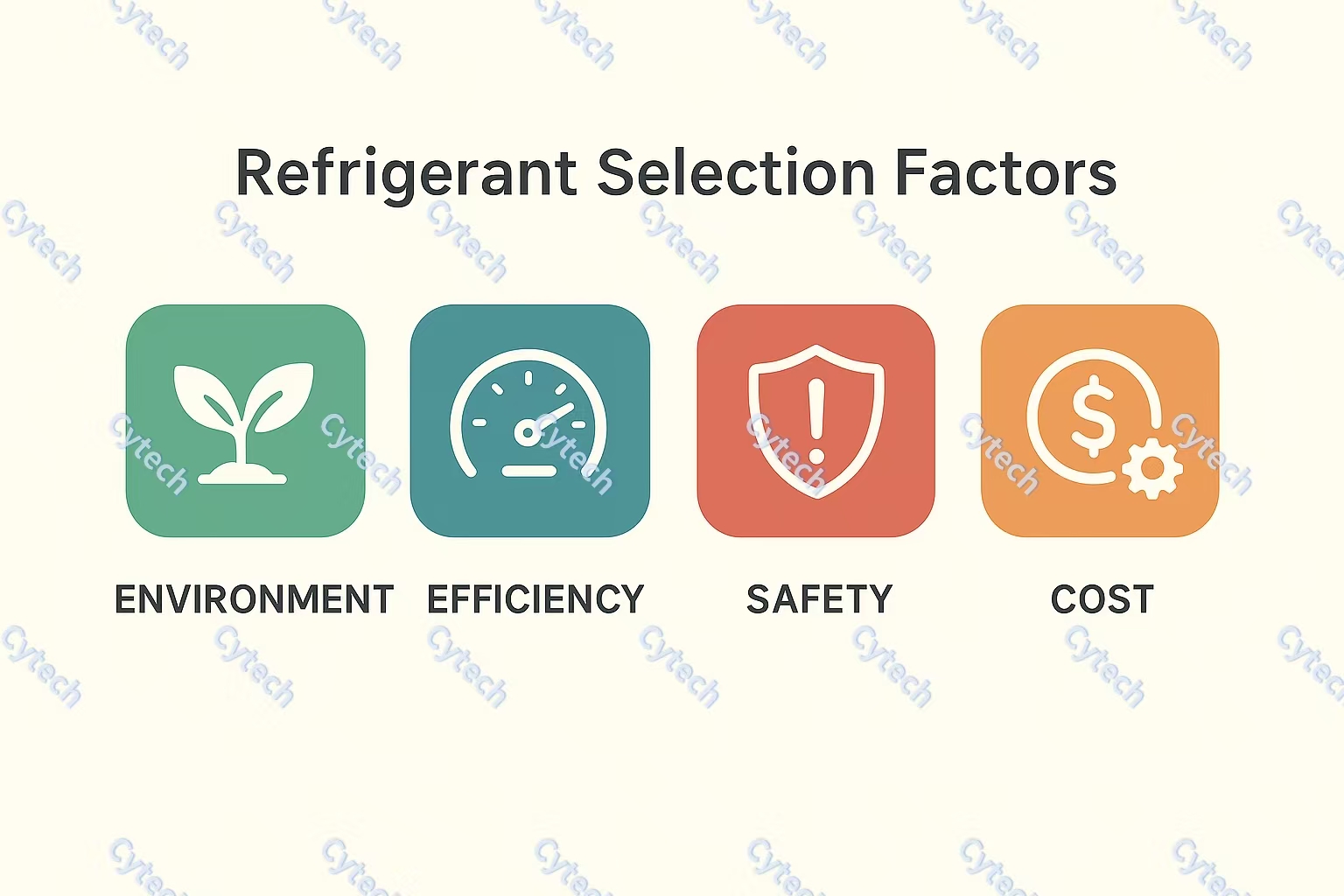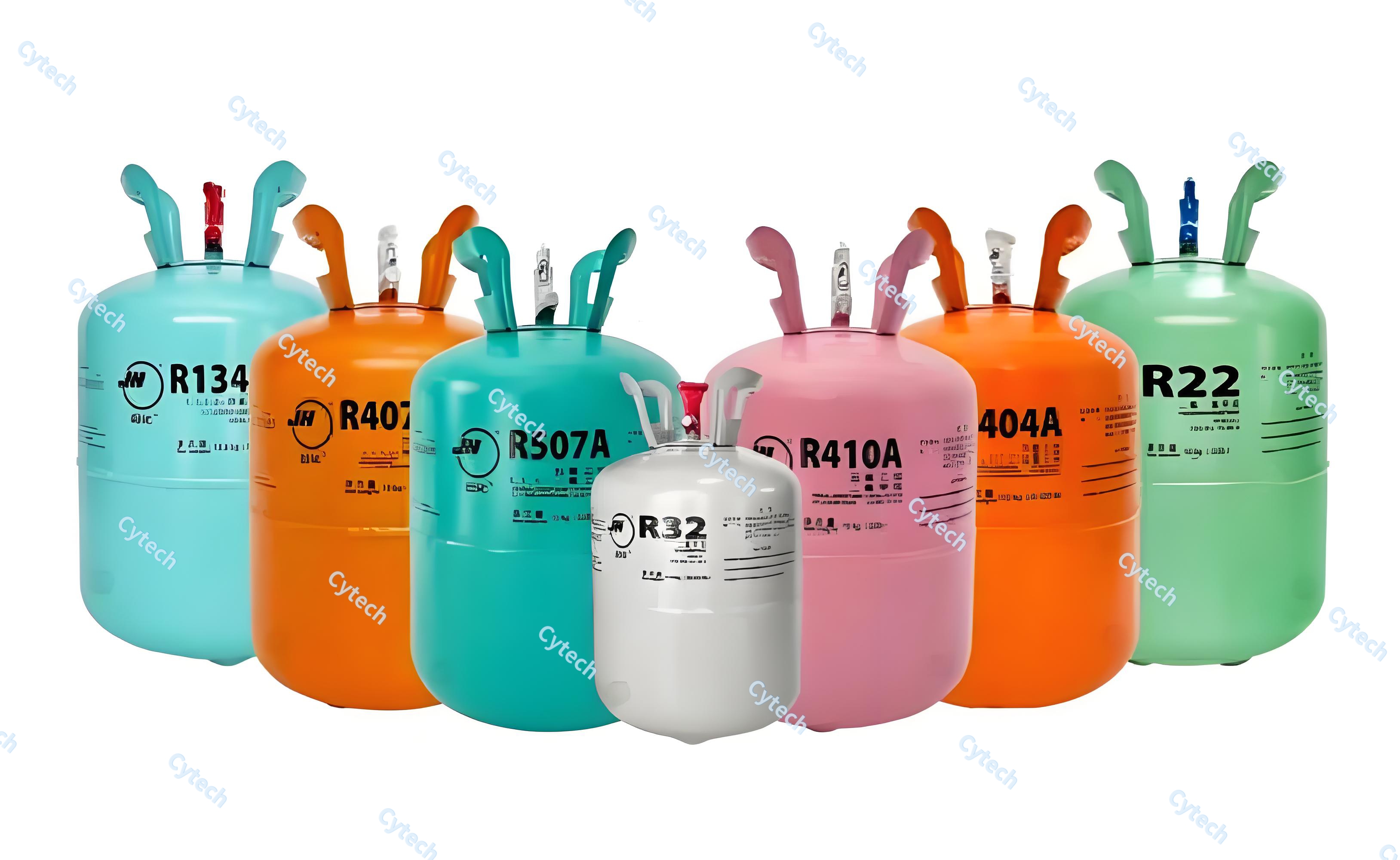With the development of the times, the application of cabinet air conditioner is becoming increasingly widespread.
Refrigerants are the key medium for achieving enclosure air conditioner. The choice of refrigerant directly affects the system's efficiency, cost, reliability, and environmental compliance.
So, how should we choose the refrigerant for our cabinet air conditioner?

This blog will answer this question in three parts.
First, I'll explain the key factors to consider when selecting a refrigerant, which will provide a clearer understanding of the key dimensions.
Second, I'll systematically review the current range of mainstream and emerging refrigerants, providing a convenient reference for their advantages, disadvantages, and applicable scenarios.
Finally, I'll provide a series of questions to consider, linking them to the refrigerant requirements of your own industrial project. This will help you gain a clearer understanding of your refrigerant selection process.
Before that, here is a video about thermal management and refrigerant filling of our cabinet air conditioner components for reference:
1. Core selection considerations for Air Conditioner Refrigerants

Before selecting a refrigerant for an industrial project, the following points must be evaluated:
1.1 Environmental Performance of Refrigerants for Enclosure Air Conditioning (Top Priority)
1.1.1 ODP and GWP: Key Environmental Metrics for Enclosure AC Refrigerants
1.1.1.1 Understanding ODP and GWP Concept in Enclosure Cooling
ODP (Ozone Depletion Potential) is a relative measure of a chemical's ozone depletion potential. Its value is the ratio of the global ozone depletion caused by a given mass of the substance to the ozone depletion caused by the same mass of CFC-11 (trichlorofluoromethane).
A higher ODP value indicates a greater ozone-depleting potential. CFC-11 has an ODP of 1, while other substances are expressed based on their relative ozone depletion potential relative to CFC-11.
GWP(Global Warming Potential) is a measure of a greenhouse gas's relative impact on global warming, using carbon dioxide as a benchmark (GWP = 1). It compares the heat absorption capacity of a unit mass of a greenhouse gas to that of the same mass of carbon dioxide over a specific time period (usually 100 years).
A higher GWP value indicates a stronger greenhouse gas's warming potential and a greater impact on global warming over a specific period of time.
1.1.1.2 ODP and GWP Reference Values for Modern Cabinet Air Conditioner Refrigerants
ODP (Ozone Depletion Potential): Must be 0. Under the Montreal Protocol, CFCs and HCFCs such as R11, R12, and R113 have been completely phased out or are in the process of being phased out (e.g., R22).
GWP (Global Warming Potential): Under the Kigali Amendment. The goal is to select refrigerants with the lowest possible GWP. High-GWP refrigerants are often subject to quota restrictions, price increases, or future bans.
1.2 Thermodynamic Properties in Enclosure Air Conditioner Design
1.2.1 Operating Pressure:
Refrigerants are classified as high-pressure, medium-pressure, and low-pressure. This affects system pressure design, compressor selection, and sealing requirements.
Therefore, the operating pressure of the refrigerant directly influences the design strength and compressor selection of a cabinet air conditioner for electrical enclosures, impacting both the initial equipment cost and long-term reliability.
1.2.2 Refrigeration Capacity per Unit Volume:
Large industrial systems tend to choose refrigerants with high refrigeration capacity per unit volume, which can reduce compressor displacement and pipeline size.
1.2.3 Critical Temperature for High-Ambient Enclosure Cooling:
Refrigerants with high critical temperatures are more advantageous for applications requiring high-temperature heating.
1.2.4 Temperature Glide (for Mixtures):
Zeotropic mixtures exhibit dew points and bubble points, and temperature glide, which can be used to implement the Lorentz cycle and improve system efficiency. However, care must be taken in charging and management.
Properly managing temperature glide can optimize heat exchange efficiency, which is a key consideration when designing a high-efficiency cabinet air conditioner with high cooling capacity for demanding industrial processes.
1.2.4.1 Lorentz Cycle: Theory and Application
· Components: The Lorentz cycle is a thermodynamic cycle consisting of two polytropic processes (i.e., variable temperature processes) with no temperature difference in heat transfer with the heat source, and two isentropic processes.
· Characteristics: It is a reversible cycle with a high cooling coefficient when the heat source temperature varies.
· Application: This cycle has theoretical advantages for use in mixed refrigerant systems and can be used to optimize mixed refrigerant design.
1.3 Safety Standards for Refrigerants in Cabinet Air Conditioner Applications
Toxicity level: From A (low toxicity) to B (high toxicity).
Flammability level: From 1 (non-flammable) to 2 (weakly flammable) to 3 (highly flammable).
Safety category: A combination of toxicity and flammability, such as A1 (safest), B2L (weakly flammable, low toxicity), and A3 (highly flammable, low toxicity). Industrial sites require rigorous assessment of leak risks and safety measures.
1.4 Balancing Efficiency (COP) and Capacity in Enclosure Cooling Systems
The operating efficiency (COP, i.e. coefficient of performance) and capacity of the refrigerant for the enclosure air conditioning are two important indicators to measure the performance of the refrigeration system, but there is no direct causal relationship between them, but they are interrelated.
1.4.1 Operating Efficiency (COP)
Definition: COP is the ratio of a refrigeration system's cooling capacity output to its electrical power input. It is a dimensionless value.
Significance: A higher COP value indicates that the system produces more cooling capacity for the same electrical power consumption, meaning higher efficiency, greater energy savings, and lower operating costs.
Influencing Factors: COP is affected by many factors, including refrigerant type, system design, and operating conditions (such as evaporation and condensing temperatures).
For a cabinet air conditioner for telecom cabinets that operates 24/7, selecting a refrigerant and system design that delivers a high COP is essential for minimizing lifetime electricity costs.
1.4.2 Determining System Cooling Capacity
Definition: Capacity is the amount of heat a refrigeration system can transfer and remove in a specific time, usually expressed in kW or tons of refrigeration (RT).
Significance: Capacity determines how much space or load a refrigeration system can cool.
1.4.3 Relationship between COP and Capacity
Not a direct causal relationship: An increase in COP does not necessarily mean an increase in capacity, and vice versa. For example, a low-capacity but high-efficiency system may have a higher COP, while a large-capacity but low-efficiency system may have a lower COP.
Common Goal: When selecting and designing a cooling system, the goal is to maximize the system's COP while maintaining the required capacity to achieve energy savings and consumption reductions.
Trade-off considerations: In actual applications, it is necessary to balance the specific application requirements (such as space size, load requirements, etc.) and economic costs, and choose a system that can meet capacity requirements and ensure high efficiency.
The balance between COP and capacity is a central design challenge for manufacturers developing cabinet air conditioner with easy installation, aiming to provide a plug-and-play solution that does not compromise on energy efficiency or cooling power.
1.4.4 Optimizing for Efficiency and Capacity in Cabinet AC Unit Design:
COP measures cooling efficiency, while capacity measures cooling capacity. In practical applications, we strive to maximize the system's COP while meeting the required capacity, in order to achieve better economy and energy efficiency.
1.5 Cost and Availability for Enclosure Air Conditioner Refrigerants
The price of the refrigerant itself, the charge amount, and the cost and compliance of future maintenance and replenishment of the enclosure ac.
1.5.1 Refrigerant Price
Refrigerant prices are affected by type and region:
Type differences: Prices of different refrigerants (e.g., R-134a, R-410A, R-32, etc.) vary significantly, with newer, low-global warming potential (GWP) refrigerants generally being more expensive than older refrigerants.
Region and Supply and Demand: Prices are influenced by local market supply and demand, regional regulations, and suppliers.
When budgeting for a project involving multiple cabinet air conditioner for outdoor cabinets, it's important to consider not just the upfront refrigerant cost but also its long-term price stability and availability.
1.5.2 Refrigerant Charge Amount
The charge amount is determined by the equipment model and refrigeration capacity:
Determined by equipment capacity: The refrigerant charge amount is not a fixed value but is determined by the model and capacity of the specific refrigeration equipment (such as air conditioners and refrigerators).
Professional Inspection: Refrigerant charging must be performed by a professional refrigeration equipment maintenance technician according to the equipment manual and actual conditions. Overcharging or undercharging will affect equipment performance and lifespan.
1.5.3 Future Maintenance and Replenishment Costs
Future maintenance costs and compliance depend on the type of refrigerant. For example, some newer refrigerants have higher environmental standards and higher initial costs, but may reduce long-term maintenance costs.
Refrigerant loss and leakage: Normal refrigerant loss is normal, but if there is a large leak, the leak must be located and repaired, and then refilled, which incurs additional repair costs.
Regular Inspections: For older equipment, regular inspections are recommended to detect and replenish small amounts of refrigerant in a timely manner to avoid poor cooling performance due to insufficient refrigerant.
Choosing a refrigerant with low leakage rates and stable future availability can significantly reduce the total cost of ownership for enclosure air conditioning systems deployed across a large facility.
1.5.4 Compliance Requirements
Regulatory restrictions: Globally, the use of refrigerants is becoming increasingly stringent, particularly for refrigerants with high global warming potential (GWP), which are gradually being banned or restricted.

2. Selection range of mainstream industrial refrigerants
The following table lists the mainstream refrigerant categories and representative products suitable for industrial air conditioning (including process cooling, large chillers, etc.).
Refrigerant code | type | Environmental characteristics (ODP/GWP) | Safety Level (ASHRAE) | Main features and applicable scenarios | Note |
R-717 (Ammonia) | Natural refrigerant | 0/~0 | B2L (toxic, weakly flammable) | Advantages: Excellent thermodynamic performance,extremely high efficiency, and low cost. Disadvantages: Toxic,pungent odor,and incompatible with copper. Applications: Large-scale industrial refrigeration, food freezing, and chemical processes. Rarely used for direct-to-human air conditioning due to its toxicity. | A leader in industrial refrigeration, with a long history and mature technology. Requires a dedicated machine room and strong ventilation. |
R-744 (CO₂) | Natural refrigerant | 0 / 1 | A1 (Safety) | Advantages: Extremely environmentally friendly, non-toxic, non-flammable, and high cooling capacity per unit volume. Disadvantages: Low critical temperature (31°C), drastic efficiency drop at high temperatures, and extremely high system pressures. Applications: Low-temperature stages of cascade systems, heat pump water heaters, and transcritical cycle air conditioners/heat pumps in cold regions. | This is a research hotspot for high-temperature heat pumps and applications with extremely stringent environmental requirements. High-pressure-resistant equipment is required. |
R-134a | HFC | 0 / 1430 | A1 | Advantages: Previously used as a replacement for R12 and R22, it boasts a mature and safe technology. Disadvantages: High GWP, which is being gradually reduced. Applications: Medium- and high-temperature chillers, centrifugal compressors, and automotive air conditioners. | It is still widely used at present, but will be eliminated in the long run. |
R-410A | HFC Blend | 0 / 2088 | A1 | Advantages: High-pressure refrigerant, excellent heat transfer performance, and high energy efficiency. Disadvantages: High GWP, high-pressure system. Applications: Mainstream household and multi-split air conditioners, and some small and medium-sized commercial air conditioners. | It is less common in the industrial field and is mainly used in comfort air-conditioning modules. |
R-32 | HFC | 0 / 675 | A2L (weakly flammable) | Advantages: GWP is approximately 70% lower than R410A, allowing for smaller charge sizes, while maintaining comparable or slightly higher efficiency. Disadvantages: Weakly flammable, requiring compliance with charge size limits and safety standards. Applications: Increasingly becoming the primary refrigerant for residential and light commercial air conditioning. | It is an important transitional choice among current HFCs. |
R-1234ze(E) | HFO | 0 / <1 | A2L (weakly flammable) | Advantages: Extremely low GWP, excellent environmental performance, and thermal properties similar to R134a. Disadvantages: High cost and low flammability. Applications: New centrifugal chillers, high-temperature heat pumps, and foaming agents. | It is one of the long-term solutions to replace R134a. |
R-1234yf | HFO | 0 / <1 | A2L | Advantages: Extremely low GWP, with physical properties very similar to R134a. Disadvantages: Very high cost, weak flammability. Applications: A standard replacement for European mobile air conditioners, also beginning to be used in some stationary air conditioners. | Due to cost issues, its promotion in the industrial field is slow. |
R-513A | HFO/HFC blends | 0 / 573 | A1 | Advantages: 60% lower GWP than R134a, non-flammable, and a direct replacement for R134a (drop-in replacement subject to evaluation). Disadvantages: Higher cost than R134a. Application: Used to replace existing R134a chillers. | Common "bridging" transitional solutions. |
R-454B | HFO/HFC blends | 0 / 466 | A2L | Advantages: 78% lower GWP than R410A, making it a leading alternative to R410A. Disadvantages: Weakly flammable, requiring new system design, not a direct replacement. Applications: A design option for future new residential and commercial air conditioners/heat pumps. | Alternatives are developing rapidly. |
R-515B | HFO/HFC blends | 0 / 299 | A1 | Advantages: Non-flammable, low GWP, designed to replace R134a in medium-temperature applications. Disadvantages: Requires design for new equipment. Applications: New chillers and heat pumps. | Its non-flammable nature makes it advantageous in certain locations. |
Our factory's industrial air conditioners(enclosure air conditioner with high cooling capacity &cabinet air conditioner for small enclosures)primarily use refrigerants such as R-134a and R-410A.
Secondly, our factory offers customized services, providing one-on-one project support tailored to each customer's specific needs.
3. How to choose a refrigerant for your cabinet air conditioner project?
Here's a simplified decision-making process:
3.1 Defining Your Enclosure Cooling Requirements
◆ Determine the application scenario and operating conditions
◆ Is it process cooling or comfort air conditioning?
◆ What is the required evaporating temperature/chilled water temperature?
◆ What is the condensing temperature/cooling water temperature?
◆ What is the maximum/minimum ambient temperature?
3.2 Confirm Environmental Regulatory Requirements for Industrial AC Refrigerants
Consult your country's F-Gas regulations or equivalent policies to understand quotas, ban schedules, and usage restrictions for high-GWP refrigerants.
3.3 Conducting a Site-Specific Risk Assessment for Refrigerant Safety
Is the installation site an open factory area or a closed machine room? What are the ventilation conditions?
What is the occupancy density? Can Class B (toxic) or A2L/A3 (flammable) refrigerants be accepted?
Based on the safety level, determine the maximum allowable charge.
3.4 Performing a Technical and Economic Analysis for Optimal Refrigerant Choice
Perform thermodynamic cycle calculations for several preselected refrigerants, comparing key parameters such as COP, cooling capacity, and exhaust temperature.
Calculate the total cost of ownership (TCO): equipment cost (which may vary depending on the pressure), refrigerant cost, operating electricity costs, and maintenance costs.
3.5 Leveraging Manufacturer Expertise for Your Cabinet AC Project
Communicate closely with compressor, unit, and core component manufacturers. They have extensive application data and experimental experience, enabling them to provide the most practical recommendations.
For example, centrifugal compressors commonly use R1233zd(E), R1336mzz(Z), and R515B; screw compressors have a wider range of applications.
Thank you for your reading!














